 W
WThe Black Triptychs are a series of three triptychs painted by the British artist Francis Bacon between 1972 and 1974. Bacon admitted that they were created as an exorcism of his sense of loss following the suicide of his former lover and principal model, George Dyer. On the evening of 24 October 1971, two days before the opening of Bacon's triumphant and career-making retrospective at the Grand Palais, Dyer, then 37, alcoholic, deeply insecure and suffering severe and long-term depression, committed suicide through an overdose of drink and barbiturates in a room at the Paris hotel Bacon had allowed him to share during a brief period of reconciliation following years of bitter recrimination.
 W
WBlood on the Floor is a 1986 oil-on-canvas panel painting by the British artist Francis Bacon. The panel shows a violent splash of blood, formed from drips of paint, on a bare canvas coloured floor, which may be a wooden plank, or diving board, against a harsh, flat, orange background. The forground contains two suspended light bulbs, one white, one molten yellow, and a light switch.
 W
WCrucifixion is an early oil on canvas painting by Francis Bacon, made in 1933 when the artist was aged 23-24. It was one of three paintings on the subject of the Crucifixion that he made in 1933, the others being his Crucifixion with Skull, commissioned by the art collector Sir Michael Sadler, and Wound for a Crucifixion. It is held in Damien Hirst's Murderme Collection.
 W
WCrucifixion is a 1965 triptych painted by the Irish-born artist Francis Bacon. Across each of the three panels, the work shows three forms of violent death.
 W
WFigure with Meat is a 1954 painting by the Irish-born artist Francis Bacon. The figure is based on the Pope Innocent X portrait by Diego Velázquez; however, in the Bacon painting the Pope is shown as a gruesome figure and placed between two bisected halves of a cow.
 W
WFragment of a Crucifixion is an unfinished 1950 painting by the Irish-born figurative painter Francis Bacon. It shows two animals engaged in an existential struggle; the upper figure, which may be a dog or a cat, crouches over a chimera and is at the point of kill. It stoops on the horizontal beam of a T-shaped structure, which may signify Christ's cross. The painting contains thinly sketched passer-by figures, who appear as if oblivious to the central drama.
 W
WHead I is a relatively small oil and tempera on hardboard painting by the Irish-born British figurative artist Francis Bacon. Completed in 1948, it is the first in a series of six heads, the remainder of which were painted the following year in preparation for a November 1949 exhibition at the Hanover Gallery in London. Like the others in the series, it shows a screaming figure alone in a room, and focuses on the open mouth. The work shows a skull which has disintegrated on itself and is largely a formless blob of flesh. The entire upper half has disappeared, leaving only the jaw, mouth and teeth and one ear still intact. It is the first of Bacon's paintings to feature gold background railings or bars; later to become a prominent feature of his 1950s work, especially in the papal portraits where they would often appear as enclosing or cages around the figures. It is not known what influences were behind the image; most likely they were multiple – press or war photography, and critic Denis Farr detects the influence of Matthias Grünewald.
 W
WHead II is an oil and tempera on hardboard painting by the Irish-born British figurative artist Francis Bacon. Completed in 1948, it is the second in a series of six heads, painted from the winter of 1948 in preparation for a November 1949 exhibition at the Hanover Gallery, London.
 W
WHead III is an oil painting by Francis Bacon, one of series of works made in 1949 for his first one-man exhibition at the Hanover Gallery, in London. As with the other six paintings in the series, it focuses on the disembodied head of male figure, who looks out with a penetrating gaze, but is fixed against an isolating, flat, nondescript background, while also enfolded by hazy horizontal foreground curtain-like folds which seems to function like a surrounding cage.
 W
WHead IV, sometimes subtitled Man with a Monkey, is a 1949 painting by Irish-born British artist Francis Bacon, one of series of works made in 1949 for his first one-man exhibition at the Hanover Gallery, in London. It measures 82 by 66 centimetres and is held in a private collection.
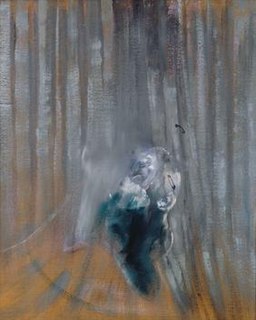 W
WHead V is a 1949 painting by Irish-born British artist Francis Bacon, one of series of works made in 1949 for his first one-man exhibition at the Hanover Gallery, in London. It measures 82 by 66 centimetres and is held in a private collection.
 W
WHead VI is an oil-on-canvas painting by Irish-born figurative artist Francis Bacon, the last of six panels making up his "1949 Head" series. It shows a bust view of a single figure, modeled on Diego Velázquez's Portrait of Innocent X. Bacon applies forceful, expressive brush strokes, and places the figure within a glass cage structure, behind curtain-like drapery. This gives the effect of a man trapped and suffocated by his surroundings, screaming into an airless void.
 W
WThe Irish-born British artist Francis Bacon (1909–1992) painted 28 known large triptychs between 1944 and 1985–86. He began working in the format in the mid-1940s with a number of smaller scale works before graduating to large examples in 1962. He followed the larger style for 30 years, although he painted a number of smaller scale triptychs of friend's heads, and after the death of his former lover George Dyer in 1971, the three acclaimed "Black Triptychs".
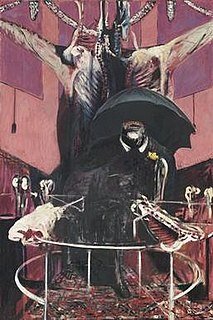 W
WPainting 1946, also known as Painting or Painting (1946), is an oil-on-linen painting by the Irish-born artist Francis Bacon. It was originally intended to depict a chimpanzee in long grass ; Bacon then attempted to paint a bird of prey landing in a field. Bacon described the work as his most unconscious, the figurations forming without his intention. In an interview with David Sylvester in 1962, Bacon recalls:FB:Well, one of the pictures I did in 1946, which was the thing that's in the Museum of Modern Art ... DS:The butcher-shop picture. FB:Yes. It came to me as an accident. I was attempting to make a bird alighting on a field. And it may have been bound up in some way with the three forms that had gone before, but suddenly the line that I had drawn suggested something totally different and out of this suggestion arose this picture. I had no intention to do this picture; I never thought of it in that way. It was like one continuous accident mounting on top of another.
 W
WPortrait of Michel Leiris is a 1976 oil on canvas panel painting by the British artist Francis Bacon. It is the first of two portraits Bacon made of his close friend, the French surrealist writer and anthropologist Michel Leiris; the second followed in 1978.
 W
WSecond Version of Triptych 1944 is a 1988 triptych painted by the Irish-born artist Francis Bacon. It is a reworking of Three Studies for Figures at the Base of a Crucifixion, 1944, Bacon's most widely known triptych, and the one which established his reputation as one of England's foremost post-war painters.
 W
WStudy after Velázquez is a large 1950 panel painting by the Irish-born English artist Francis Bacon. After Head VI, it is the second of Bacon's long series of paintings influenced by Diego Velázquez's 1650 Portrait of Innocent X. The panel shows a full length view of the pope, engulfed in vertical folds that may be either the linings of a curtain or the bars of a cage.
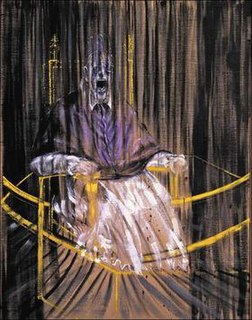 W
WStudy after Velázquez's Portrait of Pope Innocent X is a 1953 painting by the artist Francis Bacon. The work shows a distorted version of the Portrait of Innocent X painted by Spanish artist Diego Velázquez in 1650. The work is one of the first in a series of around 50 variants of the Velázquez painting which Bacon executed throughout the 1950s and early 1960s. The paintings are widely regarded as highly successful modern re-interpretations of a classic of the western canon of visual art.
 W
WStudy for a Bullfight, Number 2 is an oil on canvas painting by Francis Bacon executed in 1969. The painting now belongs to the Museum of Fine Arts of Lyon, which acquired it in 1997. It is the second on a series of three paintings which also include Study for a Bullfight, Number 1 and Study for a Bullfight, Number 3, all executed in 1969.
 W
WStudy for a Self-Portrait—Triptych, 1985–86 is a triptych painted between 1985 and 1986 by the Irish born artist Francis Bacon. It is a brutally honest examination of the effect of age and time on the human body and spirit, and was painted in the aftermath of the deaths of many of his close friends. It is Bacon's only full-length self-portrait, and was described by art critic David Sylvester as "grand, stark, ascetic".
 W
WStudy for Crouching Nude is a 1952 painting by the Irish-born artist Francis Bacon. It was painted in the Spring of 1952, and shows a perched figure whose form was likely derived from Muybridge's Man Performing a Standing Jump. The painting was first displayed – in place of Study for Portrait (1949) – at Recent Trends in Realist Painting at the Institute of Contemporary Arts, London, from July to August 1952.
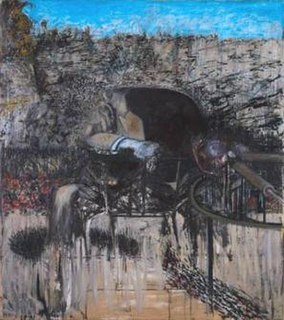 W
WFigure in a landscape is a 1945 painting by the Irish-born artist Francis Bacon. Based on a photograph of Eric Hall dozing on a seat in Hyde Park, also the basis of another painting, Figure in a landscape (1945), which was bought by Diana Watson and later in 1950 by the Tate Gallery.
 W
WStudy for Portrait II is a small 1955 oil on canvas painting by the Irish-born British figurative artist Francis Bacon, one of a series of six portraits completed after viewing that year the English poet, painter and printmaker William Blake's life mask at the National Portrait Gallery in London.
 W
WStudy from Innocent X is a 1962 painting by Francis Bacon. Based on the Portrait of Innocent X by Diego Velázquez, the work depicts a distorted image of the red-robed pope, sitting on a dark red chair on a platform inside a cuboid cage indicated by thin black lines, standing on a light brownish yellow floor with a curved lighter red wall behind.
 W
WStudy of Red Pope 1962. 2nd version 1971 is a 1971 painting by Francis Bacon. It failed to sell at auction in October 2017 with an estimate of £60-80 million. It had not been on public display for 45 years until viewings for its 2017 auction. It is a reinterpretation of his 1962 painting Study from Innocent X. Bacon's lover George Dyer is portrayed in the right side of the painting. The work was shown at the 1971 retrospective of Bacon's work at the Grand Palais.
 W
WThree Figures in a Room is a 1964 oil-on-canvas triptych painting by British artist Francis Bacon. Each panel measures 198 × 147 centimetres (78 × 58 in) and shows a separate view of his lover George Dyer, whom Bacon first met in 1963. It is the first of Bacon's works to feature Dyer, a model to whom he returned repeatedly in his paintings. The work has been described as Bacon's first secular triptych.
 W
WThree Studies for a Crucifixion is a 1962 triptych oil painting by Francis Bacon. It was completed in March 1962 and comprises three separate canvases, each measuring 198.1 by 144.8 centimetres. The work is held by the Solomon R. Guggenheim Museum in New York.
 W
WThree Studies for a Portrait of Henrietta Moraes is an oil on canvas 1963 triptych by the Irish-born British figurative painter Francis Bacon. It is one of a series of portraits he painted of his friends, at a time when his art was becoming more personal. Henrietta Moraes (1933–1999) was a close friend and drinking companion of Bacon's from the early 1960s, and became one of his favourite models. She never posed in person for him; instead he worked either from photographs commissioned from John Deakin or from memory.
 W
WThree Studies for Figures at the Base of a Crucifixion is a 1944 triptych painted by the Irish-born British artist Francis Bacon. The canvasses are based on the Eumenides—or Furies—of Aeschylus's Oresteia, and depict three writhing anthropomorphic creatures set against a flat burnt orange background. It was executed in oil paint and pastel on Sundeala fibre board and completed within two weeks. The triptych summarises themes explored in Bacon's previous work, including his examination of Picasso's biomorphs and his interpretations of the Crucifixion and the Greek Furies. Bacon did not realise his original intention to paint a large crucifixion scene and place the figures at the foot of the cross.
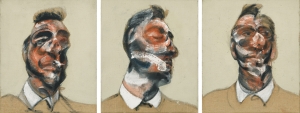 W
WThree Studies for George Dyer is a small-format triptych painted by Francis Bacon in 1964.
 W
WThree Studies of Muriel Belcher is an oil on canvas triptych painting by the Irish born English artist Francis Bacon, completed in 1966. It portrays Muriel Belcher, described by musician George Melly as a "benevolent witch", and the charismatic founder and proprietress of The Colony Room Club, a private drinking house at 41 Dean Street, Soho, London, where Bacon was a regular throughout the late 1940s to late 1960s. The two became friends soon after she opened the club in 1948, and Bacon helped her cultivate its reputation as a seedy but convivial meeting place for artists, writers, musicians, homosexuals and bohemians. At its height, regular patrons included Lucian Freud, Jeffrey Bernard, John Deakin and Henrietta Moraes.
 W
WThree Studies of the Male Back is a 1970 oil-on-canvas triptych by the British painter Francis Bacon. Typical of Bacon's figurative but abstract and distorted style, it depicts male figures isolated within flat nondescript interior spaces. Each figure is a portrait of Bacon's lover George Dyer.
 W
WTriptych Inspired by the Oresteia of Aeschylus is a 1981 oil on canvas triptych painting by Francis Bacon. It is one of 28 large triptych paintings by Bacon, each comprising three oil on canvas panels which measure 198 cm × 147.5 cm.
 W
WTriptych–August 1972 is an oil on canvas triptych by the British artist Francis Bacon (1909–1992). It was painted in memory of Bacon's lover George Dyer who committed suicide on 24 October 1971, the eve of the artist's retrospective at Paris's Grand Palais, then the highest honour Bacon had received.
 W
WTriptych, 1976 is a large triptych painted by the British artist Francis Bacon in 1976. It comprises three oil and pastel paintings on canvas. It is the second most expensive Bacon ever sold, after Three Studies of Lucian Freud, being auctioned for US$86 million in 2008.
 W
WTriptych, May–June 1973 is a triptych completed in 1973 by the Irish-born artist Francis Bacon (1909–1992). The oil-on-canvas was painted in memory of Bacon's lover George Dyer, who committed suicide on the eve of the artist's retrospective at Paris's Grand Palais on 24 October 1971. The triptych is a portrait of the moments before Dyer's death from an overdose of pills in their hotel room. Bacon was haunted and preoccupied by Dyer's loss for the remaining years of his life and painted many works based on both the actual suicide and the events of its aftermath. He admitted to friends that he never fully recovered, describing the 1973 triptych as an exorcism of his feelings of loss and guilt.
 W
WThe Irish-born artist Francis Bacon (1909–1992) painted 28 known triptychs between 1944 and 1986. He began to work in the format in the mid-1940s with a number of smaller scale formats before graduating in 1962 to large examples. He followed the larger style for 30 years, although he painted a number of smaller scale triptychs of friend's heads, and after the death of his former lover George Dyer in 1971, the three Black Triptychs.
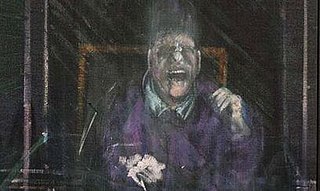 W
WUntitled (Pope) is a circa 1954 oil on canvas panel painting by the Irish born, English artist Francis Bacon, one in a series of many representations of popes he painted after Diego Velázquez's 1650 Portrait of Innocent X. Bacon was a harsh self-critic and destroyed a great many of his own paintings, many of which were created under the influence of drink. This work was long thought lost until it reemerged on the art market in 2016. It is closely related to Bacon's masterpiece, the Study after Velázquez's Portrait of Pope Innocent X in the Des Moines Art Center, Iowa.
 W
WVersion No. 2 of Lying Figure with Hypodermic Syringe is a 1968 oil on canvas panel painting by the Irish born, English artist Francis Bacon. It is the second of two similarly titled paintings based on nude photographs of his close friend Henrietta Moraes, who is shown in a reclining position on a bed, themselves part of a wider series of collapsed figures on beds that began with the 1963 triptych Lying Figure. This later version is widely considered the more successful of the two panels.